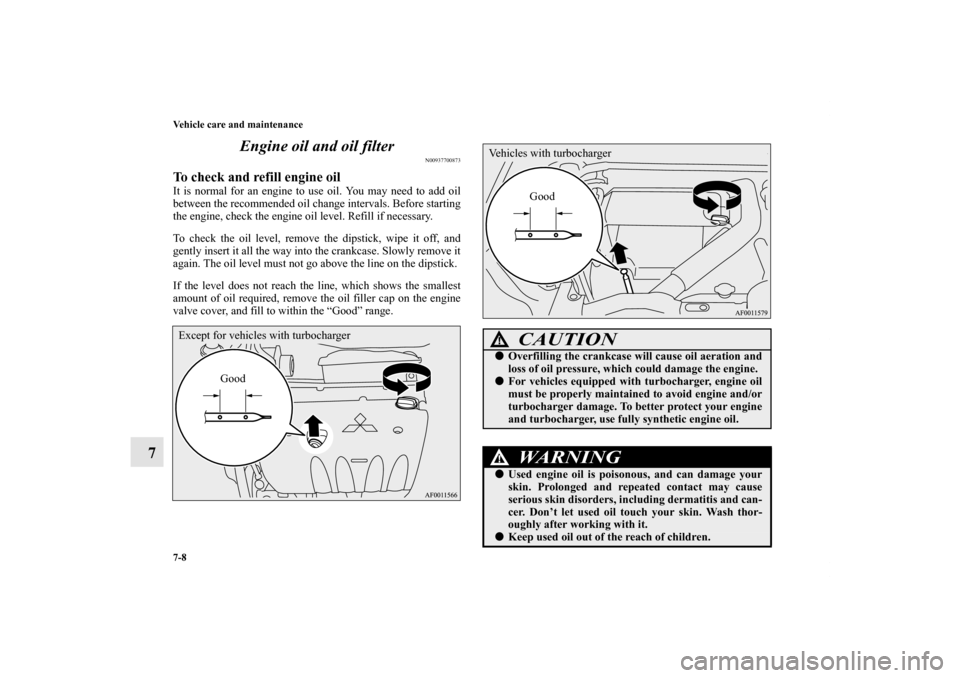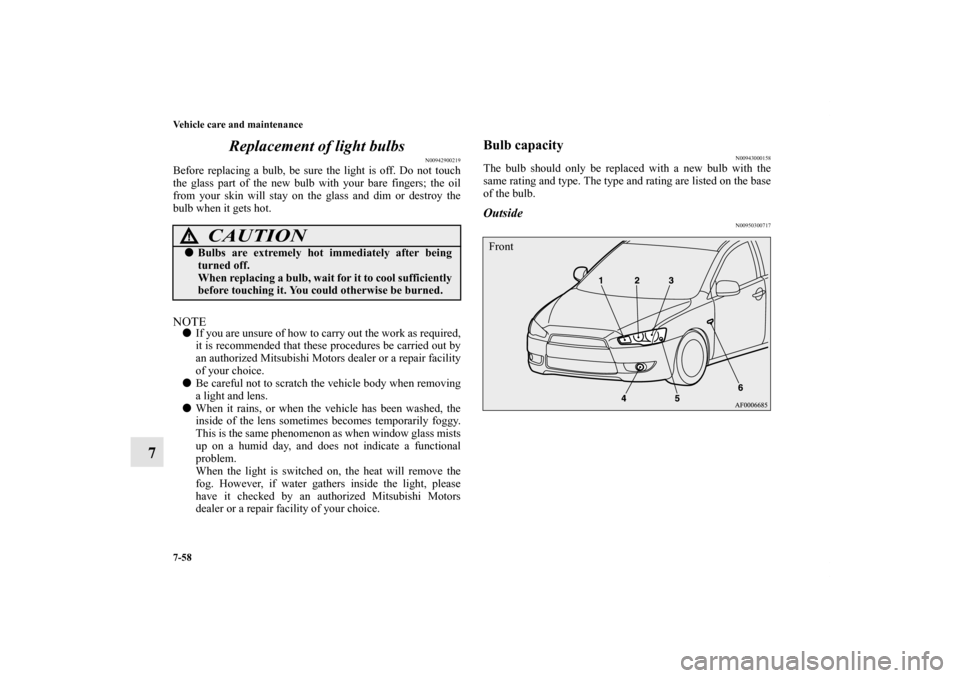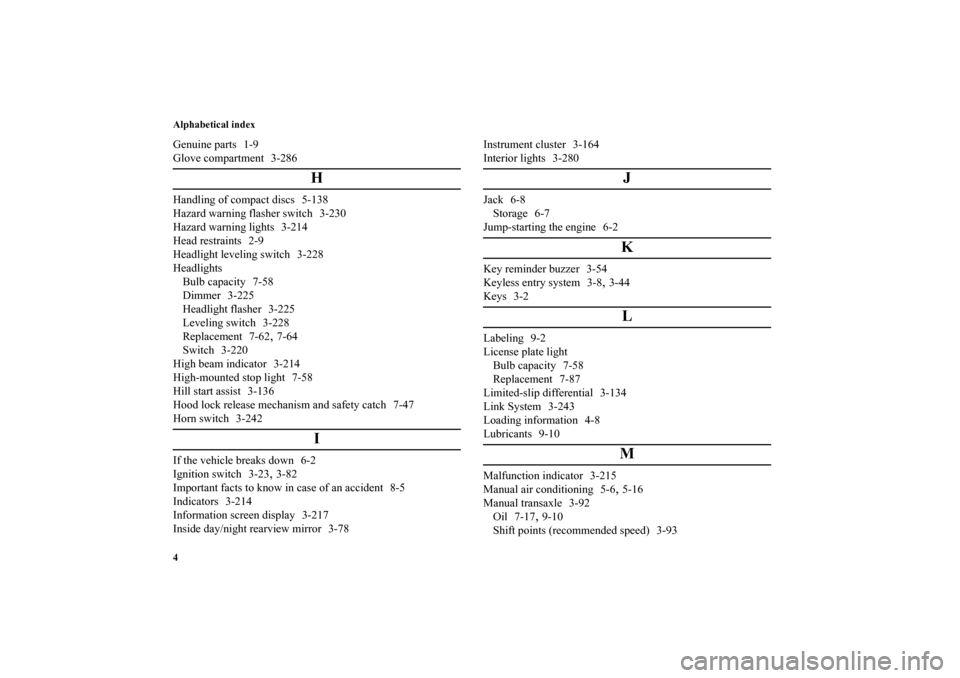Page 587 of 706

7-8 Vehicle care and maintenance
7Engine oil and oil filter
N00937700873
To check and refill engine oil It is normal for an engine to use oil. You may need to add oil
between the recommended oil change intervals. Before starting
the engine, check the engine oil level. Refill if necessary.
To check the oil level, remove the dipstick, wipe it off, and
gently insert it all the way into the crankcase. Slowly remove it
again. The oil level must not go above the line on the dipstick.
If the level does not reach the line, which shows the smallest
amount of oil required, remove the oil filler cap on the engine
valve cover, and fill to within the “Good” range.
Good Except for vehicles with turbocharger
CAUTION
!�Overfilling the crankcase will cause oil aeration and
loss of oil pressure, which could damage the engine.�For vehicles equipped with turbocharger, engine oil
must be properly maintained to avoid engine and/or
turbocharger damage. To better protect your engine
and turbocharger, use fully synthetic engine oil.
WA R N I N G
!�Used engine oil is poisonous, and can damage your
skin. Prolonged and repeated contact may cause
serious skin disorders, including dermatitis and can-
cer. Don’t let used oil touch your skin. Wash thor-
oughly after working with it.�Keep used oil out of the reach of children.Vehicles with turbocharger
Good
BK0125300US.book 8 ページ 2010年5月18日 火曜日 午後1時53分
Page 589 of 706
7-10 Vehicle care and maintenance
7
Recommended engine oil viscosity
N00955000083
Use engine oil with the proper thickness for the outdoor tem-
peratures where you will be driving.Except for vehicles equipped with turbochargerSAE 0W-20 engine oil is strongly recommended for optimum
fuel economy and cold starting.
If SAE 0W-20 is not available, the ILSAC certification oil of
other viscosity grades can be temporarily used.
Vehicles equipped with turbochargerNOTE�Select engine oil of the proper SAE viscosity number
according to the atmospheric temperature.
�SAE 0W-30 and 0W-40 engine oil are recommended to
use to improve engine startability on a very cold weather
condition.
BK0125300US.book 10 ページ 2010年5月18日 火曜日 午後1時53分
Page 614 of 706

Vehicle care and maintenance
7-35
7
Replacing tires and wheels
N00939600371
Tire maintenance
N00939700154
The following maintenance steps are recommended:
�Check tire pressures regularly.
�Have regular maintenance done on the wheel balance and
front and rear suspension alignment.
�Rotate your tires regularly as described in the “Tire rota-
tion” section on page 7-37.
CAUTION
!�Avoid using different size tires and wheels from the
ones listed, and avoid the combined use of different
types of tires and wheels. Using different size or type
tires and wheels may affect driving safety.
Refer to “Tires and wheels” on page 9-9.�For All-wheel drive vehicles, always use tires of the
same size, same type, and same brand, and which
have no wear differences. Using tires that differ in
size, type, brand or the degree of wear, will increase
the differential oil temperature, resulting in possible
damage to the driving system. Further, the drive
train will be subjected to excessive loading, possibly
leading to oil leakage, component seizure, or other
serious problems.�Even if a wheel has the same rim size and offset as
the specified type of wheel, its shape may prevent it
from being fitted correctly. Consult an authorized
Mitsubishi Motors dealer or a repair facility of your
choice before using wheels that you have.�Only Mitsubishi Motors genuine wheels should be
used, because your vehicle is equipped with a tire
pressure monitoring system.
Use of another type of wheel risks air leaks and sen-
sor damage, as it will not be possible to install the
tire pressure sensor properly.
BK0125300US.book 35 ページ 2010年5月18日 火曜日 午後1時53分
Page 637 of 706

7-58 Vehicle care and maintenance
7Replacement of light bulbs
N00942900219
Before replacing a bulb, be sure the light is off. Do not touch
the glass part of the new bulb with your bare fingers; the oil
from your skin will stay on the glass and dim or destroy the
bulb when it gets hot.NOTE�If you are unsure of how to carry out the work as required,
it is recommended that these procedures be carried out by
an authorized Mitsubishi Motors dealer or a repair facility
of your choice.
�Be careful not to scratch the vehicle body when removing
a light and lens.
�When it rains, or when the vehicle has been washed, the
inside of the lens sometimes becomes temporarily foggy.
This is the same phenomenon as when window glass mists
up on a humid day, and does not indicate a functional
problem.
When the light is switched on, the heat will remove the
fog. However, if water gathers inside the light, please
have it checked by an authorized Mitsubishi Motors
dealer or a repair facility of your choice.
Bulb capacity
N00943000158
The bulb should only be replaced with a new bulb with the
same rating and type. The type and rating are listed on the base
of the bulb.Outside
N00950300717
CAUTION
!�Bulbs are extremely hot immediately after being
turned off.
When replacing a bulb, wait for it to cool sufficiently
before touching it. You could otherwise be burned.
Front
BK0125300US.book 58 ページ 2010年5月18日 火曜日 午後1時53分
Page 701 of 706

Alphabetical index
4Genuine parts 1-9
Glove compartment 3-286
H
Handling of compact discs 5-138
Hazard warning flasher switch 3-230
Hazard warning lights 3-214
Head restraints 2-9
Headlight leveling switch 3-228
Headlights
Bulb capacity 7-58
Dimmer 3-225
Headlight flasher 3-225
Leveling switch 3-228
Replacement 7-62
,7-64
Switch 3-220
High beam indicator 3-214
High-mounted stop light 7-58
Hill start assist 3-136
Hood lock release mechanism and safety catch 7-47
Horn switch 3-242
I
If the vehicle breaks down 6-2
Ignition switch 3-23
,3-82
Important facts to know in case of an accident 8-5
Indicators 3-214
Information screen display 3-217
Inside day/night rearview mirror 3-78Instrument cluster 3-164
Interior lights 3-280
J
Jack 6-8
Storage 6-7
Jump-starting the engine 6-2
K
Key reminder buzzer 3-54
Keyless entry system 3-8
,3-44
Keys 3-2
L
Labeling 9-2
License plate light
Bulb capacity 7-58
Replacement 7-87
Limited-slip differential 3-134
Link System 3-243
Loading information 4-8
Lubricants 9-10
M
Malfunction indicator 3-215
Manual air conditioning 5-6
,5-16
Manual transaxle 3-92
Oil 7-17
,9-10
Shift points (recommended speed) 3-93
BK0125300US.book 4 ページ 2010年5月18日 火曜日 午後1時53分